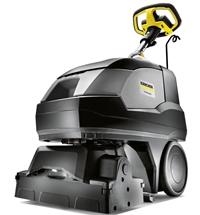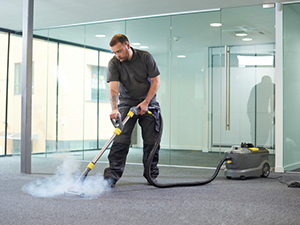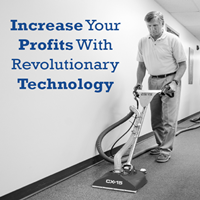
From HVAC systems to plumbing to flooring, everything within a building must be properly maintained over time to function efficiently and cost effectively.
Regardless of the type of building, location, or square footage, building owners and managers not only invest in products that will create an inviting and comfortable space, but also consider the intended lifespan and return on investment (ROI).
When it comes to carpet, life expectancy ranges extensively based on use and care over the first several years. Proper carpet care can result in extending the life of carpet by decades.
However, putting off carpet care for too long—allowing soils and stains to become permanent and wearing down or tearing fibers—can cut carpet lifespan down significantly.
Facility managers who adhere to best practices can better protect their investment while upholding the aesthetic of their buildings.
Make the right investment
Carpet offers a variety of benefits within commercial facilities, including contributing to the overall atmosphere of the environment and the ability to limit noise.
When selecting carpet, consider the following details and features:
- Placement—Will carpet be placed wall-to-wall or only in certain areas of the building? If carpet is placed near entrances and exits, it is best to opt for a durable carpet and supplement it with matting that can capture soils and moisture. Likewise, if carpet is placed in areas where food and drinks are served or made, installing stain-resistant carpet, or using a stain-block product will be helpful.
- Durability—Carpet tiles have become increasingly popular, as they are incredibly durable and easy to install and even replace as needed. That said, not all carpet tiles or traditional carpet is made to withstand decades of use, so it is essential to discuss the durability of a product with the manufacturer.
- Construction—Most commercial facilities select tufted carpet due to its simple installation process and low price point. However, carpet made with 100 per cent wool or wool blends can offer an upscale look and feel while also remaining easy to maintain. The construction of carpet matters not only for design purposes, but it will also impact the products you need to effectively clean and maintain it over time.
- Sustainability—Today, there are numerous ways to reduce a building’s environmental footprint. For carpet, it is important to consider the manufacturer’s dedication to sustainable materials and processes, as some carpeting is treated with harmful substances. You can also select carpet made with recycled materials.
Strategies for success
After selecting the right carpet for your facility, it is time to develop a maintenance plan. Most quality commercial carpet has a life expectancy of 10 to 30 years.
To reach the maximum life expectancy, it requires proper care on a regular basis.
The four cornerstones of a smart carpet care program include preventative maintenance, daily maintenance, interim maintenance, and restorative maintenance.
Uphold these cornerstones by implementing the following strategies:
- Vacuum every day—Nearly 85 per cent of soil is tracked into facilities from guests’ shoes. Depending on the location and season, this can include everything from sand, salt, dirt, and more. When soil remains on carpet, it sinks down into the fibers and accumulates, making it more difficult to remove. To effectively remove soils from carpet, it is essential to not only vacuum every day, but invest in a high-quality vacuum.
- Install matting—In addition to dry soils, wet soils like rain, snow, and mud often find their way into facilities. Installing matting at entrances and exits, as well as in high-traffic and common areas, can help to reduce soils from reaching carpet. Quality matting traps soils and reduces the risk of stains that require additional effort and product to remove.
- Provide regular training—Commercial cleaning roles often experience high turnover. Not only that, but carpet and floor care require a consistent approach. If a spill is not attended to right away, it will stain the carpet. If soils build up over the course of a week, it is much less likely they will be effectively removed with one pass of a vacuum. Maintaining carpet to the highest standards requires thorough and frequent training over the course of each employee’s tenure.
- Practice low-moisture carpet care—Otherwise known as interim cleaning, low-moisture carpet care helps protect carpet appearance at a low cost, while also extending the life of the carpet. Excessive moisture is a quick way to impact carpet lifespan, leading to mold and mildew growth. By using low-moisture carpet cleaning systems consisting of machines and chemistry, carpet will stay clean. It is also a very sustainable cleaning method, as it requires little water and energy.
- Maintain machinery—Carpet cleaning machines require regular maintenance to function as intended and effectively remove soils from carpet. After each use, make sure to rinse off the brushes and inspect them for any issues, such as damaged bristles, which could mean it is time for a replacement. Take a close look at spray nozzles that distribute cleaning chemicals as well, as they can become clogged over time.
- Conduct annual or biannual deep cleans—It is a good idea to determine a time each year to perform a deep clean to ensure any remaining soils are effectively removed. It is recommended to use a certified company for hot water extractions to ensure it is done properly and does not damage the carpet.
Invest in your floor’s future
To ensure your carpet lasts for decades to come, it is a must to invest in proven carpet cleaning technology, cleaning strategies, and training.
The state of your facility’s carpet impacts the satisfaction of your guests and occupants.
Carpet care also contributes to your triple bottom line and future success.
Joe Bshero is the director of technical services with R.E. Whittaker Co. This article was first published by CMM and was republished with permission in the latest issue of INCLEAN magazine.
Comment below to have your say on this story.
If you have a news story or tip-off, get in touch at info@incleanmag.com.au
Sign up to INCLEAN’s newsletter.



